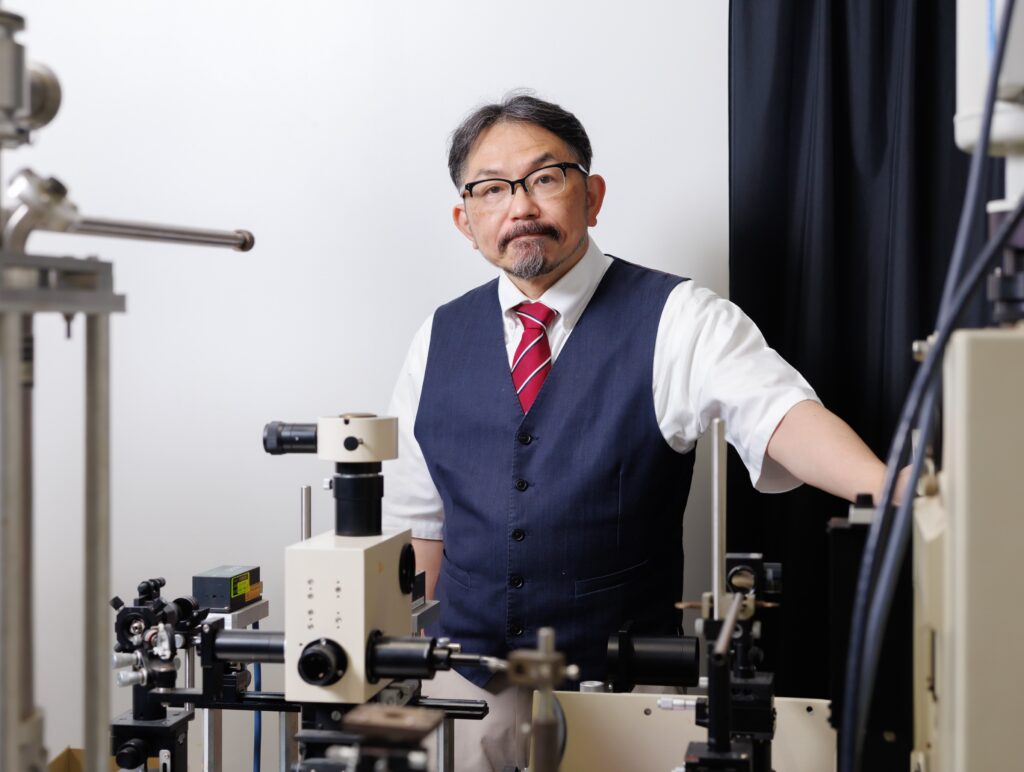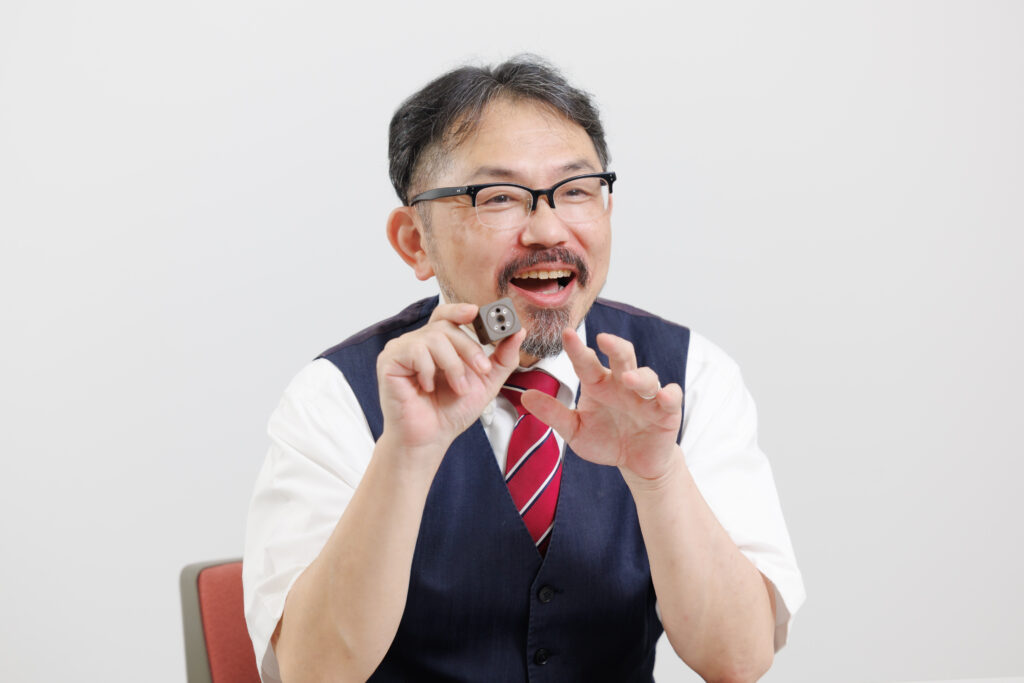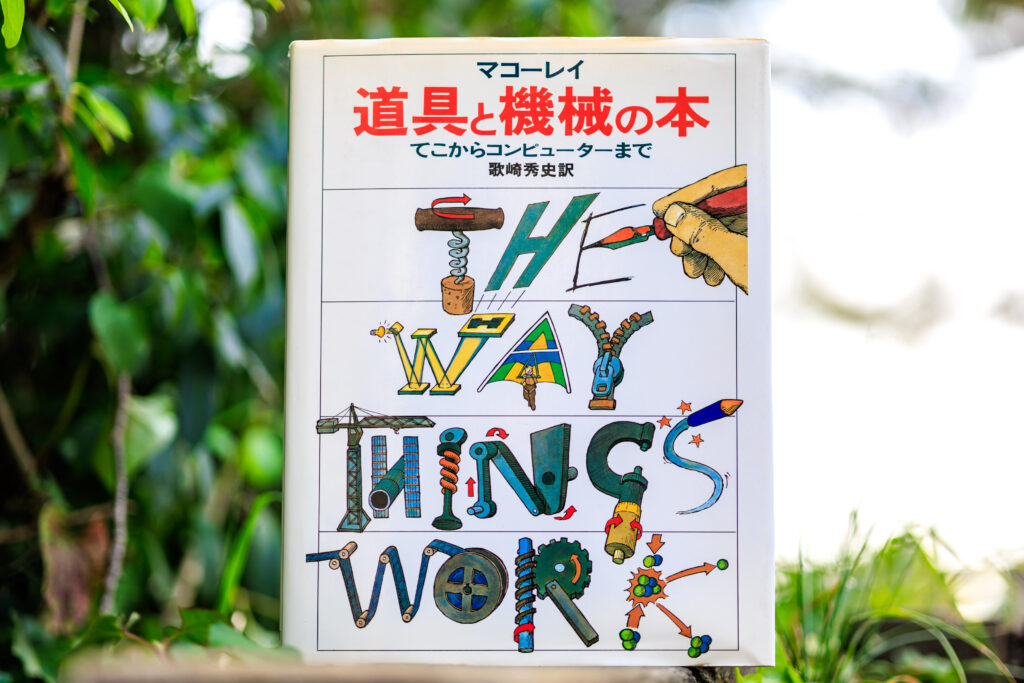
According to Associate Professor Haruhiko Kuroe of the Faculty of Science and Technology, a solid-state physicist who investigates how material changes in multi-extreme conditions, “physics truly demonstrates its prowess in the situation when all other options have been exhausted”—but what, exactly, is this prowess to which he refers?
One of my research topics involves measuring physical properties under what are termed “multi-extreme conditions.” This refers to several environments very far from our daily life.
I investigate the properties of materials under the conditions of minus 270 degrees Celsius, 100,000 atmospheres, and magnetic fields some 200,000 times stronger than what we feel on the Earth’s surface.
My research begins with artificially generating the multi-extreme conditions that do not occur in the natural world. The diamond-anvil cell is used for the application of high pressure.
This device contains a pair of diamonds facing each other, and tightening a metal plate with a small hole between them.
The sample, a very small crystal, is placed on one of the diamonds alongside fine ruby powders, which are used for pressure sensing in addition to the sample.
The diamond anvil cell is a small device, measuring just three centimeters in length, width, and height, but it is easily capable of creating pressures up to 100,000 atmospheres. When the cell is cooled by liquid helium without decreasing the pressure, we can achieve both extremely high pressure and extremely low temperatures to create “multi-extreme conditions.”
We observe the sample in the multi-extreme condition through the diamond using a microscope, allowing us to illuminate the sample with a laser light. Instead of just looking at it, we use a tool called a spectrometer to measure the fluorescent or scattering spectrum.
The ultimate goal of my research is to measure how the material changes under these conditions and develop theories to explain our results.
The Prowess of Physics

I believe that physics truly demonstrates its prowess as a field of study when all other options have been exhausted. Physics enables us to construct theories from scratch, providing explanations for problems that other subjects may find challenging—although this sounds a slightly more circuitous way of doing things.
Let me give you an example from the start of the 20th century when people were trying to find a method for measuring temperatures inside blast furnaces. Of course, this was at a time when sensors capable of withstanding high temperatures did not exist.
Physicists considered an imaginary “black body” to model the surface of a furnace. They explored how the wavelengths of the light are related to the temperature of this black body.
Finally, physicists found a new way to measure the temperature inside a furnace using scientific methods instead of relying on skilled craftsmen’s estimates. This discovery played a big role in helping the steel industry grow. This is a clear example of how physics evolved after all other options had been exhausted.
But the story doesn’t end there. Physicists later discovered that classical physics was insufficient to establish a theory that could be universally applied to the light emitted by all bodies at all temperatures—from the far-infrared light emitted by a human body to the visible light emitted by a very hot white dwarf in the night sky. Consequently, physicists developed a new framework known as “quantum mechanics.” This is a great example of the prowess of physics.
Today’s Discoveries, Future’s Commonplace
It is not easy to predict how and when the findings of physics research will be implemented in society.
A non-contact thermometer, now widely used to measure our bodies from a distance, was considered cutting-edge technology a century ago and was found in limited facilities such as blast furnaces.
Physics is a research field that bridges the microscopic world, accessible only through the lens of the scientific method, and the macroscopic world that encompasses our daily society. The role of physicists is to share the knowledge of various phenomena with others, using our findings with logical explanations.
Like we accept the existence of X-rays and atomic structures, both of which were discovered by physicists a century ago, today’s discoveries will be commonplace in the future.
The book I recommend
“The Way Things Work”
by David Macaulay, Japanese translation by Hidefumi Utasaki, Iwanami Shoten

This book provides illustrated explanations for how various things work, from electric guitars to boring machines. I remember being fascinated by the book when I read it as a child; even when I became a researcher I opened the book sometimes and fantasized myself writing similar books. I also well remember buying the original English version on the spur of the moment while overseas.
-
Haruhiko Kuroe
- Associate Professor
Department of Engineering and Applied Sciences
Faculty of Science and Technology
- Associate Professor
-
Associate Professor Haruhiko Kuroe graduated from the Department of Physics, Faculty of Science and Technology, Sophia University, and received his Ph.D. in science from the university’s Graduate School of Science and Technology. After working as an assistant and assistant professor at the Department of Physics, Faculty of Science and Technology, Sophia University, Kuroe was appointed to his current position in April 2016.
- Department of Engineering and Applied Sciences
Interviewed: July 2023